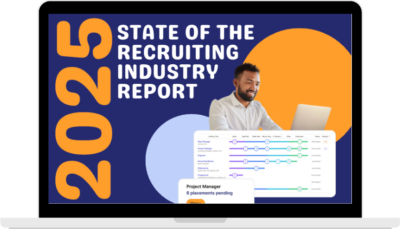Staffing and recruiting professionals are no strangers to impossible expectations. One day you’re asked to fill a highly specialized role in record time. The next, you’re juggling multiple hiring managers, each convinced their requisition should be your top priority. Add in the realities of today’s candidate-driven market—talent shortages, ghosting, counteroffers—and it’s easy to feel like success is out of reach.
“Recruiters today are often asked to do the impossible,” says Barb Bruno, CPC/CTS, President of Good as Gold Training. “They’re balancing competing priorities, trying to satisfy clients, and navigating a talent pool that knows it’s in demand.”
But Bruno believes that nothing is truly impossible for a resourceful recruiter. To prove her point, she draws inspiration from an unlikely teacher: the humble bumble bee.
The Bumble Bee Lesson
According to the laws of aerodynamics, the bumble bee shouldn’t be able to fly. Its body is too heavy for its wings, the math doesn’t work, and on paper it looks impossible.
But the bumble bee doesn’t know this. So it flies anyway.
Recruiters face their own version of this paradox daily. Market conditions, candidate behaviors, and client demands often appear insurmountable. But like the bumble bee, recruiters can choose not to believe in limits.
“If you think you can’t fill your open job orders, you’re right,” Bruno cautions. “But if you choose to believe you can—and you adapt your approach—you’ll find ways to succeed.”
The bumble bee isn’t weighed down by doubt, and recruiters shouldn’t be either.
The Candidate-Driven Market: Why “Posting and Praying” Doesn’t Work
There was a time when posting a job on a website or job board yielded a flood of applicants. But in today’s market, the best candidates don’t come through job ads.
Bruno puts it plainly: “Posting and praying is not effective. Proactive recruiting is the solution.”
Here’s why:
-
Only 15% of the workforce is actively looking. Your ads are competing for the same small group of people everyone else is chasing.
-
The best talent is off the market in 10–14 days. If your process drags, you lose.
-
Passive candidates hold the real power. These are the 85% who aren’t actively searching but could be persuaded by the right opportunity.
A recruiter who relies solely on job postings is playing checkers in a chess match. To win, you need to take a proactive, strategic approach—researching, sourcing, networking, and building relationships that go beyond one requisition.
The “Impossible” Problems Recruiters Face—and How to Overcome Them
Recruiters often feel overwhelmed by recurring frustrations: ghosting, no-shows, no-starts, offer turndowns, and counteroffers. These challenges can feel impossible to solve, but Bruno insists they’re symptoms of deeper issues that can be addressed.
1. Ghosting and No-Shows
Few experiences sting more than being ghosted by a candidate you thought was solid. But Bruno challenges recruiters to ask why it happens.
“When you point the finger at an ‘irresponsible candidate,’ remember there are three fingers pointing back at you,” she says.
Candidates ghost when:
-
They don’t see the benefit of staying engaged.
-
They feel the recruiter only cares about filling a job, not their career.
-
They don’t trust the process or the recruiter’s motives.
Solution: Stop leading with job pitches. Instead, lead with curiosity.
Don’t cram job details into an email, voicemail, or InMail. Instead, suggest a conversation about the candidate’s career goals. Build trust by showing interest in what matters most to them.
2. Offer Turndowns and Counteroffers
Offer turndowns can derail weeks of effort, and counteroffers are an ever-present threat. But both can be reduced with stronger discovery early in the process.
Bruno recommends a simple but revealing question: “If you were your boss, what five things would you change about your current job?”
The answers uncover pain points that money and promotions can’t fix—like lack of advancement, poor culture, or weak leadership. These are the motivators that counteroffers can’t resolve.
She also suggests asking: “What must be there for you to make a change today?” This identifies non-negotiables and allows you to position opportunities more effectively.
When you understand a candidate’s “why,” you’re less likely to lose them to last-minute surprises.
3. No-Starts and Early Attrition
Sometimes, candidates accept offers but don’t show up on day one—or they quit within weeks. While frustrating, these outcomes are preventable.
Solution: Stay engaged after the offer is signed.
-
Maintain consistent contact during the notice period.
-
Encourage clients to begin onboarding early with welcome packages, team introductions, or pre-start meetings.
-
Remind candidates why they made the move in the first place.
“Engagement and retention don’t begin on day one of employment—they start during the recruiting process and continue throughout onboarding,” Bruno explains.
Shifting From Job-Centric to Candidate-Centric Recruiting
Traditional recruiters focus on the requisition: filling the open job as quickly as possible. But candidates recognize when they’re being treated like a transaction.
Bruno encourages a shift: “Don’t pitch the job. Pitch the conversation.”
Instead of leading with the role, conduct general interviews that explore a candidate’s goals, motivators, and long-term vision. This candidate-first approach builds trust.
When you later present a role that aligns with their goals, you’re not selling—you’re advising. And even if the timing isn’t right, you’ve laid the groundwork for future placements.
Resourcefulness: The Bumble Bee Mindset in Action
The bumble bee doesn’t waste time doubting whether it can fly. It simply finds a way. Recruiters can adopt the same mindset by becoming resourceful problem-solvers.
Be Creative With Sourcing
-
Go beyond LinkedIn by exploring niche forums, alumni associations, and industry events.
-
Use Boolean search techniques to uncover hidden profiles.
-
Leverage employee referral programs and offer incentives for introductions.
Build Relationships, Not Transactions
-
Stay in touch with “silver medalists”—the strong candidates who didn’t land the role.
-
Share career resources and industry insights to add value outside of active searches.
-
Position yourself as a long-term career advisor.
Communicate With Transparency
-
Be clear about client expectations, timelines, and processes.
-
Keep candidates updated, even if the update is “no news yet.”
-
Transparency builds trust, and trust reduces ghosting.
Measure and Adapt
-
Track metrics like time-to-fill, offer acceptance rates, and candidate satisfaction.
-
Identify bottlenecks—sourcing, interviewing, offers—and refine processes continuously.
“A resourceful recruiter is one who doesn’t stop at the first obstacle,” Bruno says. “They find another route, another tool, another question to ask. That’s what separates average recruiters from great ones.”
Case Study: Two Recruiters, One ‘Impossible’ Role
Imagine two recruiters asked to fill a high-demand technical position for a critical client.
-
Recruiter A posts the job online and waits. Applicants trickle in, but none are qualified. She blames the market. Weeks pass with no placement.
-
Recruiter B starts by reaching out to passive candidates, asking about their career goals. She conducts exploratory interviews and uncovers what would motivate them to move. She stays engaged, even when candidates say “not now.” Within days, she presents three strong fits.
Recruiter B didn’t perform magic. She simply chose to be the bumble bee—refusing to believe the task was impossible, and approaching the challenge with creativity and resilience.
Why Nothing Is Impossible in Recruiting
Recruiting will always present obstacles: ghosting, no-shows, counteroffers, and demanding clients aren’t going away. But declaring these issues “impossible” ensures failure.
When you shift your mindset, ask better questions, and prioritize candidates as people rather than transactions, the impossible becomes achievable.
As Bruno reminds us: “Just like the bumble bee, realize there is nothing that is impossible when you are a resourceful recruiter.”
Conclusion: Choose to Fly
Recruiters are often handed impossible tasks. But like the bumble bee, you don’t need to listen to the voices that say it can’t be done.
Stop posting and praying. Start proactively sourcing. Stop blaming candidates for ghosting. Start building conversations around their goals. Stop fearing counteroffers. Start uncovering the motivators that money can’t fix.
By embracing resourcefulness and resilience, you’ll not only fill jobs—you’ll build relationships, strengthen retention, and earn long-term trust from both candidates and clients.
The next time you feel like you’re being asked to do the impossible, remember the bumble bee. It doesn’t argue with physics. It just flies. And so can you.








